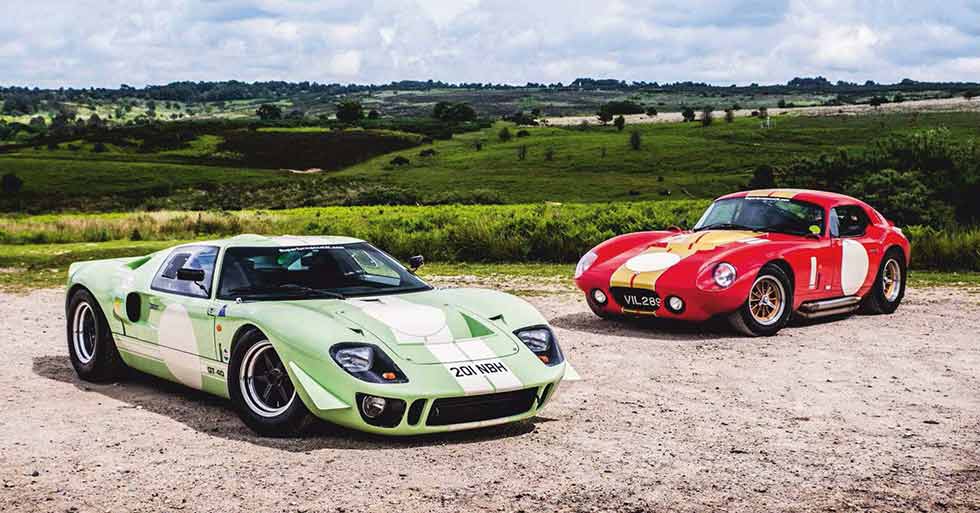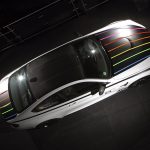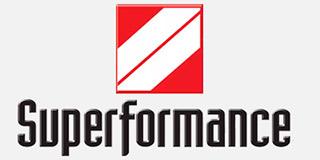
Le Mans Replicas. The Ford GT40 and Shelby Cobra Daytona were legends of Le Mans. These two are as close to official copies as possible – so within reach of mortals. Words John Simister. Photography Jayson Fong.
LE MANS REPLICAS GT40 vs. COBRA DAYTONA REPS How dreams become reality
When I was a child, the Ford GT40 was my favourite racing car. It probably still is. I close my eyes and I’m transported back to the 1960s, when the GT40 was in endurance racing’s frontline and GT40-shaped slot racers from Cox and Monogram zoomed around my Scalextric track in the attic.

Sometimes the blue Cox model with white stripes raced against a model I’d concocted out of a Lindberg static kit and an Airfix-MRRC Clubman Special chassis. It was also blue with paired white stripes and it also miniaturised a Shelby-run racing car. It was a Cobra Daytona Coupe.
Now, unbelievably a half-century later, I am looking at full-size examples of each. But they are not half-a-century old. They are new. The GT40 is a faithful continuation of the original, with a legitimate bloodline, the Daytona is a little different: it has grown slightly, and it has a Chevrolet motor, but the architecture is pretty much as was.
These cars are built by Hi-Tech Pty in Port Elizabeth, South Africa, a company also known as Superformance, and come into the UK via Le Mans Coupes Ltd, formed in 2003 by ex-racer Nigel Hulme with son Oliver also now on board, the GT40s carry continuation chassis numbers starting at P/2000 (the originals mostly wore P/1000 numbers), and around 85% of their components are interchangeable with those of original 1960s GT40s. You could also speculate that some of the ‘original’ GT40s you see racing today are actually recreations based around these cars, with the originals staying safely tucked away. But that’s another story.

The Shelby Daytona Cobra Mkll, as the car you see here in red-and-gold Alan Mann team colours is called, gained the approval of Carroll Shelby himself when the design was completed, although achieving that wasn’t without its tripwires. He took umbrage at Hi-Tech’s first version, to the extent that he had it impounded when it arrived in the US, but eventually Shelby sanctioned the modified Mkll design of this car and allowed the design to wear official CSX9000 chassis numbers. ‘Come over here to the factory,’ Hi-Tech’s Jim Price had said to Shelby, ‘and if you don’t like what you see, we’ll pack it up.’ Just for the record, though, the Daytona Cobra didn’t race in a red and gold livery in period; even those examples that were entered by Alan Mann’s equipe retained Ford’s and Shelby’s distinctive white-striped blue colour scheme.
Each of these cars has a price tag of £145,000, which seems rather good value for fully IVA-approved retro-supercars, although that can soon climb if you spec them up a bit. And now I’m going to drive them, in deepest Sussex, this could be a boyhood dream come true.
We’ve gathered at Nigel Hulme’s establishment in Crawley Down, the pale green GT40 draws me like a magnet. Ford used to have a press and sales demonstrator in the 1960s, also in green but a slightly darker shade, which I failed to drive in the 1990s after a chunk broke off its cylinder head at the old Boreham test track, the crankshaft pulley had broken up and a flying fragment caught the head, which then spewed water over the following Escort Cosworth, being driven by me.
That car was later repainted in Gulf colours, replicating the 1968 and ’1969 Le Mans winner (the same car, chassis 1075, both years), and subsequently became a visual replica of the 1966 Le Mans-winning
Mkll, with black paintwork, silver stripes, more scoops and wider front and rear bodywork, thats how it is today, and I had the immense joy of driving it up Goodwood’s hill even as the real thing was commemorating the 40th anniversary of its win over in France, that Goodwood weekend I also bought the three-car Scalextric set of those top three 1966 Mk2s.
Then there was Ford PR supremo Walter Hayes’ roadgoing GT40 Mklll, in silver, reverting to the original 1964 prototypes’ wire wheels and wearing the registration number DWC 8G. I did drive that one on the Boreham test day, my first GT40 drive experience, and was a touch disappointed after all the expectation. It had too little grip, a cantankerous centrally mounted gearchange, and it was not as quick as it should be, all pointing to too much sitting around on old tyres and not enough use.
A decade later it was red and healthier, and I did a leisurely demo lap at the Goodwood Revival (thank you Ford, again, most heartily). Shortly after that it became white and I drove it to Le Mans for a story for sister magazine Evo, followed by half-an-hour around the Bugatti circuit with the track all to myself. By then DWC 8G was much fitter, and the run cleared any residual cobwebs most efficiently. Clearly the chance to do all this was close to a transcendental experience, even though this was a long-tailed, softened, four-headlamp, ‘road-optimised’ version.
And now, here’s a brand new one like Ford’s green demonstrator used to be, looking just like the race cars. It could well go like one, too, given that its 343ci (5621cc) engine makes 395bhp.
This engine was built by Roush, Ford’s favoured V8 tuner, and features aluminium cylinder heads (like the Weslake heads on the later race cars) and what looks like a four- barrel carburettor but which actually contains eight injectors, for cleaner running and lower emissions. It was produced by FAST (Fuel Air Spark Technology), an industrial group that also includes Borla exhausts, an example of whose spectacularly sinuous work, crossover pipes and all, is also in this GT40. ‘It has been a bit of a struggle to get it all to work,’ says Nigel.
Before I descend into the driving seat with its rows of metal vent rings, I quickly take in the authentic BRM-design wheels, the smooth finish of the glassfibre doors and the clamshells front and rear, the unsettling lack of years of racetrack patina, this is what a fresh GT40 Mkl would have looked like in 1965. Or maybe 1968; this one has the later tail design (two tail-lights instead of four, re-shaped air vents) and the Mkll style of bonnet air outlet.
Now I’m inside, having climbed over the wide sill of this steel monocoque and threaded my ankles past the right-hand gearlever. The steering wheel and floor- hinged pedals look just right, as does the reproduction of the Zephyr MkIII/Corsair demister grille on top of the dashboard. I’m sitting low but the view out is better than I remember from DWC 8G, in which I sat even lower. Right. Press the red-bezelled starter button, prepare for eruption.
My, that sounds fierce. I could be in the Le Mans paddock, in a car that has hit 200mph on the 1960s-chicaneless Mulsanne straight. Now to get it into first gear, this involves a pull hard to the left, to get past the detent that guards against coming up against reverse gear’s lock-out in a moment of racing stress, before pulling the lever back into its dogleg-first position.
Clutch re-engaged – it’s very heavy but encouragingly progressive – and we’re off, through the suburbs and on to the open country, the GT40 follows every camber, darting this way and that, tetchy, fidgety.
The throttle is also heavy in action, and seems to be sticking a bit. Given the long-striding gearing, even in first, this is making the suburban crawl unintentionally exciting while also warming the brakes nicely. At the first available lay-by we stop to fix it, after which the GT40 induces less panic and things start to flow.
My mind rewinds to my time in DWC 8G, a car in gentler engine tune. It got hot in the cabin, but that’s not happening here because there’s another bit of helpful modernity: air-conditioning. It’s commonplace in today’s endurance racers – the Corvettes had it first – but in the 1960s you just sweated.
So, 2000rpm, throttles about to be opened wide, here’s a blattering blast aft, the soundwaves re-shaping into a lovely beaty roar as the revs rocket beyond 5000rpm. At yet higher revs the racing GT40s, the small- block ones at least, have quite a high-pitched note with not much of a beat, almost as though they have flatplane crankshafts, thanks to the crossover exhaust system. I suspect this one would sound the same were it to rev to 7000rpm or so, but it’s not tuned to do that, with maximum power at 5800.
With the engine thus awoken, the GT40s tetchiness and low-speed clumsiness vanish. Now I can savour the super-quick turn-in, the feeling of a car tense, eager, micro- accurate and suddenly much narrower, the steering quickly gets heavy as the cornering forces build but there’s less kickback than I expected from that earlier camber-following. Once there’s energy working the wheels, the Ford – can we call it that? – comes together.
I soon get the hang of driving it precisely, as it demands. Even that hefty gearchange is working with me, its definite movements actuating foolproof synchromesh.
This gearbox is made by RBT, which bought the rights to the original ZF design.
Its casing looks like a ZF but it contains modern Quaife internals. Other ‘evolutions’ are an MGB steering rack (virtually the same dimensions and gearing as the original but readily available), aluminium petrol tanks instead of bag tanks, and aluminium suspension uprights instead of magnesium. Tyres are modern Avon radials.
It all works beautifully, and it feels astonishingly modern for a 1960s design despite a visual vibe so deliciously redolent of its era. I’m in love, frankly; but now there’s a Cobra Daytona to try.
The shape is as curvaceously tail-biased as I remember, with that distinctive angled slice through the rump’s oval cross-section and the way the rear wheelarches eat into the doors, but the Superformance Daytona Mkll is Xeroxed-up by around 2% in every dimension relative to the 1960s original, ‘the Mkl was very tight inside,’ Nigel explains, ‘so the Mkll has a waisted section in the chassis backbone.’ that brings the seats closer together which, with the subtle upsizing, greatly improves shoulder room.
Peter Brock and Bob Negstad designed the original Daytona development of the AC/Shelby Cobra and were behind this re- imagining. Small quarter-windows replaced the air-scoops aft of the doors, the chassis was stiffened, the suspension geometry updated to allow for deeper-dish wheels and greater adjustment, and electric windows and air-con civilised the roomier cabin.
But the most significant mutation in the genetic evolution was the replacement of the Ford pushrod V8 by a GM one. In this car’s case it’s an LS3 of 6.2 litres and 515bhp, up from the factory 430bhp thanks to a clever camshaft designed by Paul Spinks of Wortec with, amazingly, no timing overlap, the gearbox has changed, too – it’s now a Tremec Magnum, an uprated version of the T56 six- speed, in place of the original Borg-Warner.
You get to see this potent powertrain by hefting forward the impressively rigid bonnet, having first released a pair of latches from a Triumph Herald (complete with ‘M’ – for Michelotti – logos), the heat from the two giant catalytic converters now revealed may well be the trigger for the heady smell of hot glassfibre I will shortly be inhaling. With bonnet clasped shut again, I venture inside.
Despite the waisted-chassis mod there is still a huge, wide central tunnel. Ahead is a fine collection of chrome-rimmed dials and, below the central cluster, a bank of metal toggle switches. Shelby logos adorn the steering wheel’s centre and the sill kick- plates, above pairs of giant side exhausts, the starter is triggered by another toggle switch, and a further control sets the exhaust sytem’s valving to ‘1’ or ‘2’.
You won’t use T much, except perhaps on a track whose decibel meter has broken: there is no silencing at all, apart from the cats’ small aural attenuation. You’ll set off alarms, rattle windows, deafen cyclists, but in the interests of accurate reporting I have to try it, briefly. In the context of a previously tranquil road it’s insane.
So ‘2’ it is, still loud but bearable. And now, feeling the engine’s rumbustious torque, shifting through a gearbox of surprising sweetness given its capacity for that torque (except when selecting reverse, a two-handed job) and sensing the incongruity of such light steering (powered, obviously), I quickly realise that this throbbing, bellowing beast is actually dead easy to drive. Its chassis balance is tail-squirtably benign, it steers with precision and it’s easy to place accurately, the only jarring note, literally, is an excess of fidget at low speeds over imperfect roads, compounded by a choppy action from the rear suspension. Tweaking of the Ohlins dampers should fix that.
The Daytona feels much more old-school than the mid-engined GT40, though, despite both designs’ roots in the first half of the 1960s, and the updates that make it a Mkll can’t disguise that fact. However, it does have a modicum of luggage space under that vast, and openable, rear window, so it’s a better bet for a loud weekend away.
Which would I choose? The GT40, as you’ve probably guessed, for its accuracy, its air of authenticity, the sheer nostalgia-soaked drama of driving it. But the Daytona has its own hot-rod appeal, even if it’s more evocation than continuation. Either way, my boyhood, slot-racer-fed imaginings have been made real enough to satisfy decades of curiosity. It was worth the wait.
‘THE DAYTONA FEELS MORE OLD- SCHOOL THAN THE MID-ENGINED GT40, DESPITE BOTH HAVING EARLY-1960S ROOTS’
Right and below… Sit here and you’ll be hard-pushed to tell it apart from an original GT40 – except the drama is matched by greater ease of use; 395bhp V8 – being tweaked by Nigel Hulme – is still explosive. Below and right… Cobra Daytona designers Peter Brock and Bob Negstad were behind this slightly enlarged modern follow-up too; Ford power makes way for a new Corvette V8.
TECHNICAL DATA FILE SPECIFICATIONS 2018 Shelby Cobra Daytona Mkll by Superformance
Engine 6162cc V8, OHV, aluminium block and heads, electronic injection and engine management
Max Power 515bhp @ 6750rpm
Max Torque 515lb ft @ 5900rpm
Transmission Six- speed manual transaxle, rear-wheel drive
Suspension Front and rear: double wishbones, coil springs, telescopic dampers, anti-roll bar
Steering Rack and pinion, power-assisted
Brakes Vented discs
Weight 1250kg
Top speed 204mph (claimed)
0-60mph 3.7sec
TECHNICAL DATA FILE SPECIFICATIONS 2018 GT40 by Superformance
Engine 5621cc V8, OHV, mid-mounted, iron block, aluminium heads, four-barrel throttle-body fuel injection
Max Power 395bhp @ 5800rpm
Max Torque 400lb ft @ 4900rpm
Transmission Five-speed manual transaxle, rear-wheel drive
Suspension Front and rear: double wishbones, coil springs, telescopic dampers, anti-roll bar
Steering Rack and pinion
Brakes Vented discs
Weight 1150kg
Top speed 200mph (claimed)
0-60mph 3.8sec
‘A PRICE TAG OF £145,000 SEEMS RATHER GOOD VALUE FOR FULLY IVA-APPROVED RETRO-SUPERCARS’








